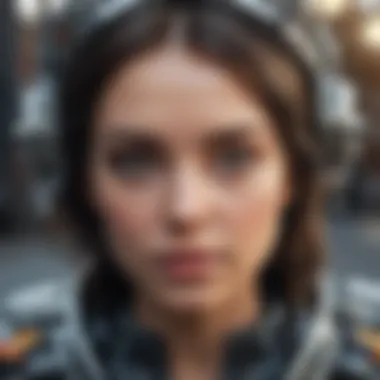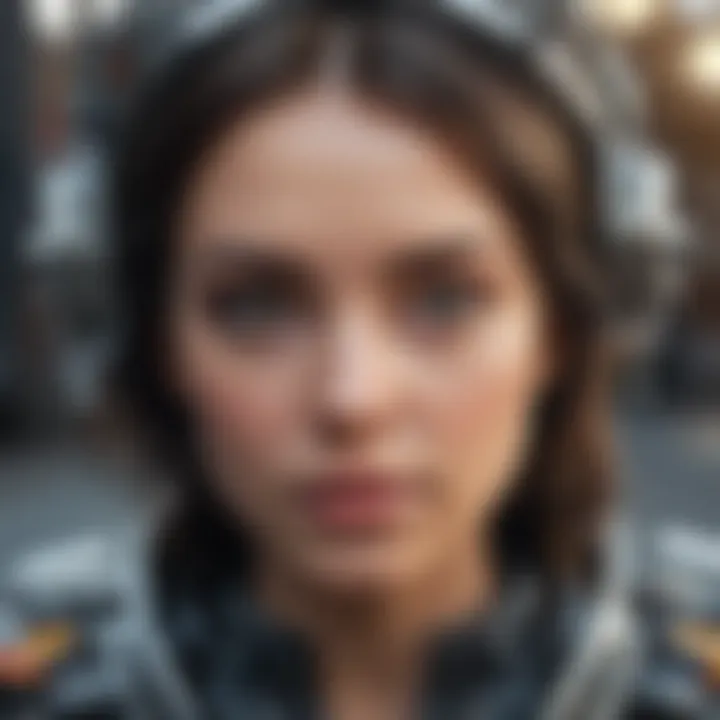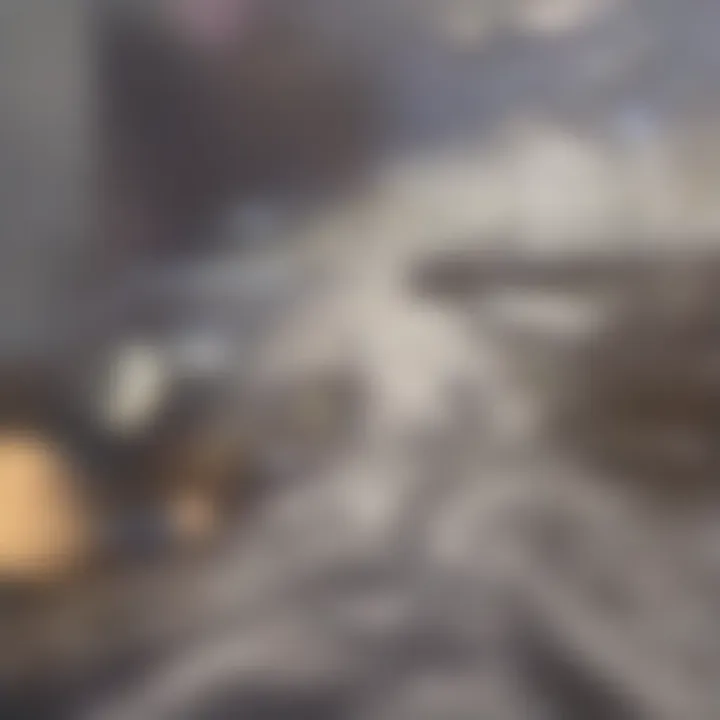Automated Photo Technology: The Future of Visual Documentation


Intro
Automated photo technology represents a significant leap in how we capture and document visual information. Through the integration of advanced algorithms and artificial intelligence, the landscape of photography has transformed, impacting various sectors from media to scientific research. The ability to automate various aspects of photography not only enhances productivity but also opens new avenues for creativity and exploration. This article intends to outline key developments in this field, examining both its historical roots and its future prospects.
Research Overview
Key Findings
- Automated photo technology has made photography more accessible and efficient, reducing the time between capture and dissemination of images.
- Artificial intelligence plays a pivotal role in enhancing image quality, identifying key features, and even automating the editing process, which was once a labor-intensive task.
- Ethical concerns arise as the technology evolves, particularly regarding consent, authenticity, and the potential for misuse.
- Future trends indicate a growing intersection between automated systems and immersive technologies, such as virtual reality, further reshaping how visual documentation is perceived.
Study Methodology
This analysis is based on a review of current literature, existing case studies, and recent technological advancements. Secondary data was collected from academic journals, articles on platforms like Britannica, and reliable online resources including Wikipedia and discussions from Reddit threads. This multi-faceted approach allows for a nuanced understanding of how automated photo technology is evolving and its implications across various fields.
Background and Context
Historical Background
The journey of automated photo technology dates back to the inception of photography itself. Early innovations in cameras and film laid the groundwork for automation. The introduction of digital photography altered the landscape significantly, paving the way for automation features like auto-focus and digital image processing. Over recent years, the rise of AI and machine learning has accelerated this transformation, enabling capabilities such as automatic tagging and advanced editing features.
Current Trends in the Field
Today, automated photo technology is prominently featured in different sectors. For instance, in journalism, tools like Adobe Photoshop have incorporated AI for faster and smarter editing options. The medical field has also embraced these technologies, using automated photo analysis for diagnostic purposes.
Moreover, advancements in software solutions have made powerful tools available to even amateur photographers, democratizing access to professional-grade equipment and techniques.
"Automated photo technology is not just a step forward; it is a complete transformation in how we engage with visual information."
Prolusion to Automated Photo Technology
Automated photo technology represents a revolutionary shift in how we capture, process, and utilize images. This section examines the critical role this technology plays in visual documentation across various fields, highlighting its importance in enhancing both efficiency and accuracy. The integration of automation significantly alters traditional photography paradigms, making it imperative for students, researchers, and professionals to grasp its implications.
Defining Automated Photo Technology
Automated photo technology encompasses a range of tools and techniques designed to streamline the process of capturing images. This includes advanced image processing algorithms that enhance photo quality, as well as artificial intelligence systems that can autonomously decide when and how to take pictures. Today, we see a fusion of hardware and software that allows for increased precision in various applications. For instance, smart cameras and drones are equipped with features that assist users in achieving optimal results with minimal manual intervention.
As the world becomes more reliant on rich visual content, understanding the nuances of automated photo technology becomes essential. This technological evolution not only improves the efficiency of capturing visual data but also democratizes access to high-quality photography.
Historical Context and Development
The journey of automated photo technology began as early as the late twentieth century with the advent of digital photography. However, significant developments accelerated in the 21st century with the proliferation of advanced computing technologies and machine learning. Early attempts at automation focused on basic tasks such as exposure and focus adjustments. Over time, innovations such as Canon's EOS series and Nikon's D-series revolutionized camera design, introducing features like automatic scene detection and intelligent autofocus.
The introduction of drones, particularly the DJI Phantom series, marked a turning point in aerial photography and monitoring capabilities. The combination of high-resolution cameras with GPS technology enabled automated capturing of large areas, proving invaluable in fields such as agriculture and environmental conservation.
The progression from manual to automated techniques illustrates a broader trend towards efficiency and precision. As these technologies continue to develop, their applications diversify, impacting everything from scientific research to media. Recognizing this historical context provides a foundation for understanding the current landscape and future trajectories in automated photo technology.
Mechanics of Automation in Photography
The mechanics of automation in photography stands as a pivotal component in understanding how technology reshapes visual documentation. This section focuses on the foundational technologies that enable automation, as well as the hardware innovations that propel the field forward. By examining these elements, we grasp not only how photography evolves but also its implications for various sectors.
Core Technologies Enabling Automation
Image Processing Algorithms
Image processing algorithms are crucial for enhancing the quality of photos. These algorithms analyze and manipulate images to improve their visual appeal through various techniques such as noise reduction, contrast adjustment, and color correction. A key characteristic of these algorithms is their ability to process large amounts of data rapidly. This speed is significant for real-time photography applications, making it a advantageous choice for professionals who require immediate results.
One unique aspect of image processing algorithms is their adaptability. They can be tailored for specific tasks like facial recognition or object detection, broadening their application scope. However, there are disadvantages. High reliance on algorithms might lead to a loss of authenticity in images, as they tend to interpret rather than capture reality directly.
Machine Learning Models
Machine learning models enhance the automation capabilities of photography by learning from vast datasets to improve shooting decisions. These models analyze patterns in images, allowing cameras to predict the best settings for different scenarios. One notable characteristic is their self-learning ability, which continuously refines their accuracy over time. This makes them a popular choice in automated systems, where precision is critical.
The unique feature of machine learning models is their capacity for personalization. They can adapt to user preferences, creating customized photographs. Yet, there are limitations; the quality of output heavily depends on the input data. If trained on biased data, these models may produce skewed results, raising concerns about their reliability.
Sensor Technology


Sensor technology forms the backbone of any automated photography system. These sensors capture light and convert it into electronic signals, influencing overall image quality. A key characteristic is their sensitivity, which determines how well they can perform in low-light conditions. This sensitivity makes advanced sensors a beneficial asset in automated photography.
Unique to sensor technology is its evolving nature. Innovations like full-frame or high-ISO sensors allow better image capture under challenging conditions. However, there are downsides, including cost and complexity. Advanced sensors can increase the price of equipment, making high-end automation less accessible.
Hardware Innovations
Autonomous Drones
Autonomous drones are revolutionizing the field of photography by providing new perspectives and capabilities. They allow photographers to capture aerial images and videos with unprecedented ease. A standout feature is their ability to operate without human intervention, which makes them efficient for various applications including real estate, events, and landscape photography.
The unique aspect of autonomous drones is their integrated GPS and camera systems enabling precise positioning for desired shots. However, regulatory issues and privacy concerns can limit their use, posing a challenge for widespread acceptance.
Smart Cameras
Smart cameras have evolved to incorporate connectivity and advanced features, facilitating automated photography. These devices can connect with the internet and other devices, allowing for immediate sharing and editing. A noteworthy feature is their ability to utilize apps that enhance functionality, making them easier to use for amateurs and professionals alike.
However, this connectivity can sometimes be a double-edged sword. While it enhances user experience, it may also raise vulnerabilities regarding data privacy and security.
Robotic Photography Systems
Robotic photography systems are designed for high precision in environments and settings where human presence is limited or impractical. They automate camera movements for capturing static shots or dynamic sequences in a consistent manner. A defining characteristic includes their programmability, enabling complex shooting tasks without human operation.
The unique advantage of these systems is their ability to perform repetitive tasks efficiently, reducing the possibility for human error. However, the initial investment in robotic systems can be high, posing a barrier for those just beginning in automated photography.
"The mechanics behind automated photography define its utility, offering diverse functionalities that fit various professional needs."
Automated photography is a multifaceted field. It encompasses advanced algorithms and innovative hardware that enhance how we capture and document visuals. By understanding these mechanics, one can appreciate the benefits and challenges, paving the way for future applications.
Applications of Automated Photo Technology
The advent of automated photo technology significantly reshapes how we document the world around us. Its relevance spans multiple domains, enabling enhanced efficiency, accuracy, and creativity in visual documentation. With automation, tasks known for their labor-intensive nature now see rapid execution, minimizing human error and maximising output. This article addresses various applications across scientific research, journalism, media, as well as the art and creative industries. Each application showcases distinct benefits and considerations, contributing to a comprehensive understanding of the technology's potential impact.
In Scientific Research
Automated photo technology is crucial in scientific inquiry due to its ability to provide precise and consistent documentation. This enhancement is vital for replicability and accuracy, which are foundational principles of research.
Data Collection in Field Studies
Automated image capture systems streamline data collection in various environments. By using techniques like remote sensing and time-lapse photography, researchers can gather vast amounts of data efficiently. This aspect is important because it enables a continuous, real-time understanding of natural phenomena.
Fields such as ecology benefit from this technology. It reduces the need for manual intervention which can often disturb ecosystems. Images collected provide insights into species behavior and habitat changes. However, reliance on technology does come risk, especially in terms of equipment failure or data corruption.
Microscopy and Imaging Techniques
Automated microscopy offers precise imaging capabilities that are critical in biological and medical research. The high-resolution output and capability for various imaging modalities let researchers visualize details that are not available to the naked eye. This technology supports advancements in drug discovery and understanding disease mechanisms.
Typically, automated systems can process images faster than traditional methods. But, challenges arise in data volume management and the interpretation of results, as large datasets may overwhelm traditional analysis methods.
Environmental Monitoring
Automated photo technology plays a significant role in environmental monitoring. Drones equipped with high-quality cameras can assess land use changes, support wildlife conservation, and monitor pollution. This area is notable for its contribution to sustainability efforts, helping scientists and policymakers make informed decisions.
Such methods provide broad spatial coverage which is tough to gather using human surveying. However, interpretation of imagery can be complex and often requires specialized training and software to analyze effectively.
In Journalism and Media
The field of journalism and media has seen profound changes thanks to automated photo technology. The speed and quality of visual news have greatly enhanced the way stories are told.
Automated News Photography
Automated news photography can capture real-time images at breaking news. By utilizing AI and robotics, news organizations can gather crucial information instantly and efficiently. With this method, the focus shifts from capturing images to curating and contextualizing them.
This automation allows for consistent coverage and helps journalists stay on top of stories. But, it also raises concerns over the loss of human touch in journalism. Automated imagery may lack the nuanced emotion found in traditional photography, potentially leading to disengaged audiences.
Covering Live Events


Covering live events poses various challenges, which automation can alleviate. Live-streamed coverage equipped with AI capabilities can provide viewers with angles and shots previously unavailable. Such technologies can ensure comprehensive coverage of events like protests, sports, or concerts.
While automated technologies can secure a broader perspective, they may miss human interactions critical for storytelling, raising concerns about audience engagement and emotional connection.
Storytelling with AI
Storytelling through AI-enhanced imagery represents a new wave in media. Here, algorithms are employed to analyze the narrative structure, guiding image selection and arrangement for optimal impact.
Tailored storytelling provides a more personalized experience for audiences, aligning with their preferences. Yet, it can also lead to ethical dilemmas regarding content manipulation and authenticity of the presented narrative.
In Art and Creative Industries
In art and creative industries, automated photo technology presents radical transformations in concepts and expressions.
Algorithmic Art
Algorithmic art employs random and deterministic processes facilitating the creation of visually engaging works. Artists can generate complex patterns or designs using coding and automated processes, helping them explore new creative territories.
This characteristics make it appealing, providing an innovative approach to artistic expression. However, it raises questions about authorship and the role of the artist in a piece generated by algorithms.
Art Restoration Imaging
In art restoration, automated imaging technologies can uncover hidden layers or forgeries in artwork. Using advanced imaging techniques, restorers can document every phase of restoration, preserving crucial historical records.
This unique feature is beneficial in maintaining artistic heritage. Nevertheless, it can also complicate the restoration process itself, as excessive manipulation can endanger the integrity of the original piece.
Innovative Visual Narratives
Innovative visual narratives combine traditional storytelling with automated technologies. The integration of photographs and graphics produced by AI can create rich, immersive experiences. This aspect is vital as it invites fresh ways of representation in digital media and enhances audience engagement.
However, there is a risk of oversaturation, where audiences may be overwhelmed by high volumes of content, leading to potential disengagement.
Through these applications, automated photo technology proves to be an invaluable asset across various fields. Its contributions are profound, offering innovative solutions for traditional challenges while also necessitating thoughtful consideration of the implications.
Impact of Artificial Intelligence on Automated Photography
The emergence of artificial intelligence has fundamentally changed the landscape of photography, particularly in automated photo technology. AI's role extends beyond mere assistance; it is a driving force behind significant advancements in image quality, processing capabilities, and user engagement. Understanding this impact is crucial for comprehending the future of photographic documentation and its applications across various sectors.
Enhancements in Image Quality and Processing Speed
Artificial intelligence has provided tools that vastly improve image quality. Through advanced image processing algorithms, AI can correct distortions, enhance colors, and optimize clarity in a way that manual methods cannot replicate. For instance, AI-based software can analyze thousands of images within seconds to determine optimal adjustments for lighting and composition. This capability allows photographers to handle larger volumes of work with greater efficiency while achieving consistent quality across their portfolios.
Moreover, AI's effectiveness in image processing speeds up workflows significantly. Tasks that previously required long hours of editing can now be done in real-time or near-real-time. Features like automatic scene detection in cameras allow immediate adjustments during photography. These innovations ensure photographers can focus on the creative aspects of their work instead of spending endless hours on technical details.
Personalization and User Interaction
With AI at the forefront, personalization in photography has reached new heights. AI algorithms can learn individual user preferences, adapting suggestions and recommendations based on previous interactions. For example, smart cameras now offer settings tailored to a user's style, creating an intuitive experience that feels more customized.
Additionally, enhanced user interaction creates a more engaging and productive experience. AI can facilitate smarter communication between photographers and their subjects or audiences. Automated systems can analyze viewer reactions in real-time, enabling photographers to adjust their approach accordingly. Such interactive elements enrich the storytelling aspect of photography, making it not just a form of art but an engaging dialogue between creator and audience.
"AI does not replace the photographer, but it enables them to create in ways that were previously unimaginable."
Considering these advancements, AI's role in automated photography cannot be understated. It shapes not only the technical aspects of photography but also influences how creators interact with their subjects and their audience. The benefits of enhanced image quality and processing speed, combined with personalized user interactions, set a foundation for an exciting future in photography.
Ethical Implications of Automated Photo Technology
Privacy Concerns
The rise of automated photo technology raises significant questions about privacy. As cameras and drones equipped with advanced imaging capabilities become more prevalent in daily life, the potential for infringing on individual privacy increases dramatically.
The prevalence of surveillance systems and automated photography in public places invites scrutiny. In various urban settings, devices capture images not only of intended subjects but also of unsuspecting bystanders. This widespread monitoring can lead to the erosion of individual privacy rights.
Moreover, social media platforms, fueled by innovations in automated photo tagging and recognition, may unintentionally compromise personal privacy. Users often unwittingly share images that allow for vast data collection, potentially leading to misuse.


"The challenge lies in finding a balance between technological advancement and the preservation of personal privacy rights."
To address these issues, it is crucial to establish clear frameworks that govern the use of automated photo technologies, ensuring they comply with existing privacy laws. Organizations operating such systems should prioritize transparency regarding data collection and consent.
Authenticity and Trust
In an age where automated photo technology is changing the landscape of visual documentation, authenticity and trust become crucial elements. Automated systems can manipulate images instantaneously, creating questions around the integrity of visual content. This raises important ethical debates about how the public perceives photography as a medium for truth-telling.
Automated photography systems, especially those driven by AI algorithms, can generate realistic images and videos that are entirely fabricated. Such capabilities can blur the lines between fact and fiction, making it difficult for audiences to discern authentic representations from altered ones. This loss of trust in visual content can have serious consequences in various fields, such as journalism, art, and even legal documentation.
Furthermore, as audiences become increasingly aware of these automation capabilities, they may begin to question the validity of images they encounter online. This skepticism can lead to broader implications for how information is consumed and understood in the digital age. Solutions must focus on developing systems that can authenticate images and provide context about their creation, thereby restoring trust with viewers.
In summary, the ethical implications of automated photo technology are multifaceted, requiring ongoing dialogue and scrutiny. Addressing privacy concerns and authenticity issues is essential not only for protecting individual rights but also for maintaining the credibility of visual media in society.
Future Trends in Automated Photo Technology
The realm of automated photo technology is constantly evolving, and understanding future trends is essential for professionals across various fields. Technological advancements shape how images are captured, processed, and analyzed. These trends reveal opportunities and challenges that could significantly alter the visual documentation landscape.
Emerging Technologies
Augmented Reality Integration
Augmented reality (AR) integration stands at the forefront of changing how photography interacts with the digital world. This technology allows users to overlay digital elements onto their physical environment, enhancing the photographic experience. The capability of AR to blend the real world with the imaginative offers a unique way to engage audiences. This renders photography not just a static representation but an interactive narrative.
A key characteristic of AR is its ability to provide context and information alongside visual material. For instance, a photograph taken during a historical event can be complemented by AR pop-ups that offer details about the subjects within the image. This feature enhances understanding and engagement. However, there are drawbacks, such as the potential for distraction. Users might focus more on digital elements than the photograph itself. Balancing these aspects is crucial for AR to be truly beneficial in the field of automated photography.
Real-Time Processing Advances
Real-time processing has begun to transform photography by allowing images to be processed and uploaded instantly. This technology is particularly important for fields like journalism where timely information is critical. The capability to shoot, edit, and share images within moments of capture ensures that stories remain relevant and engaging.
One of the standout characteristics of real-time processing is its efficiency. Automated systems can apply filters and enhancements without human intervention, streamlining workflows. As a result, content creators can focus more on storytelling and less on technical aspects. However, there is a concern regarding quality control, as automation may lead to inconsistent results. It's essential to find an equilibrium where automation aids but does not compromise image integrity.
Potential Impacts on Society
Changing Perceptions of Photography
As automated photo technology continues to evolve, so too will public perception of photography. No longer viewed merely as an art form, photography is increasingly seen as a tool influenced by technology. This change can democratize access to visual storytelling but also raises questions about authenticity. The ability to manipulate photos so easily can lead to skepticism regarding the accuracy of images.
A vital characteristic of this trend is its influence on who gets to tell stories. Anyone with a smartphone can now capture and share moments, leading to a diverse array of perspectives. However, this also means that important skills traditional photographers possessed may become undervalued over time.
The Role of Automation in Everyday Life
Automation's role in everyday life is significant, impacting how individuals document their experiences. From smartphones equipped with advanced camera features to automated editing software, these innovations make photography accessible to everyone. The act of capturing and processing photos may become second nature, seamless in daily activities.
A unique feature of this trend is how it can facilitate creativity in non-professionals. Individuals can leverage powerful tools without needing extensive knowledge of photography. Yet, there is a concern that this convenience might lead to an oversaturation of visual content, diluting the impact of powerful images.
The future of automated photo technology suggests a shift in both professional practices and personal interactions with photography. Understanding these trends is essential for adapting to the changing landscape.
Epilogue: The Future of Visual Documentation
The discussion around automated photo technology highlights its crucial role in the evolution of visual documentation. As explored in this article, automation is not just a technological advancement; it is a fundamental shift in how images are captured, processed, and interpreted. The implications of this technology are far-reaching, affecting fields from journalism to scientific research.
In considering the future of visual documentation, some specific elements emerge as pivotal. First, the increasing application of artificial intelligence is transforming traditional photography methods. AI's ability to analyze and enhance images translates into a new paradigm, where quality is noticeably improved and the speed of processing is remarkable.
Moreover, ethical considerations will become even more prominent. As automated systems become more prevalent, concerns around privacy and authenticity must be addressed. These are not just technical challenges but involve societal responsibilities that technologists must navigate.
The benefits of adopting automated photo technology are clear. Efficiency and accuracy are enhanced, allowing for comprehensive data collection and better storytelling. Yet, as with any powerful technology, it is necessary to remain vigilant about how it shapes our interactions with images and what it means for our understanding of reality.
Summary of Key Insights
- Technological Growth: Automated photo technology reflects rapid advancements in AI and hardware, leading to unprecedented changes in image documentation.
- Applications Across Fields: Its usage spans scientific research, media, and the arts. Each sector utilizes automation to improve efficiency and reach.
- Ethical Considerations: Privacy and authenticity remain critical issues as automated systems become integrated into everyday practices of capturing images.
- Societal Impact: The transformation of perception about photography calls for awareness of how we engage with visual content in daily life.
Final Thoughts on Automation in Photography
In summation, the future of photography, influenced by automation, stands at a fascinating crossroads. As automated tools become more commonplace, the potential for creativity and innovation multiplies. However, it also embodies challenges that require careful consideration.
The path forward will demand a balance between embracing automation for its advantages while critically examining its ethical dimensions. Without a doubt, the continued evolution of automated photo technology will shape not only how we document our world but also how we understand it.
"The real power of automated photo technology lies in its ability to reshape narrative experiences and invite us to rethink what 'seeing' truly means."
As advancements continue, professionals in various sectors must stay informed and adapt to these changes. This foresighted adaptability will be essential for harnessing the benefits while mitigating the risks associated with automated image technologies.







